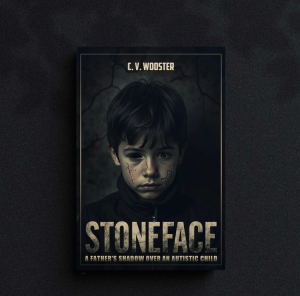Writing Stoneface: A Journey Through Autism, Trauma, and Connection
 Warning, this memoir is not for the faint of heart. It is raw, uncomfortable to read at times, and all sadly very true.
Warning, this memoir is not for the faint of heart. It is raw, uncomfortable to read at times, and all sadly very true.
Writing my memoir, Stoneface, was not just an act of storytelling but a transformative journey. As I pieced together the fragments of my life, it felt like peeling back layers of memories that had long been buried under the weight of time, trauma, and silence. This memoir is not merely a recounting of events but a deep dive into themes of resilience, isolation, and the complicated relationships that shape who we are.
Crafting Stoneface: A Memoir of ContrastsThe story of Stoneface is deeply personal yet universal. Born in the 1960s with autism, I grew up navigating a world that often felt alien. Add to that a father whose career was shrouded in secrecy—a man whose every word felt like a cipher—and you have the foundation of a narrative that is as much about deciphering others as it is about finding yourself.
My father, Clive, was a man of shadows. His career in what he vaguely referred to as “intelligence work” left our family with more questions than answers. He and his ambiguous stories often felt like riddles. But his secrecy wasn’t just a professional trait; it bled into our family life. His absence, both physical and emotional, left gaps that I spent years trying to fill.
Writing About Autism and TraumaOne of the most challenging aspects of writing Stoneface was exploring my autism diagnosis and how it shaped my perception of the world. For much of my life, I didn’t have the words or framework to explain why I felt so different. It wasn’t until much later that I learned my blunt honesty, difficulty connecting, and intense focus were part of what made me, me.
Writing about trauma, especially the kind inflicted by someone as close as your own parent, required walking a fine line. I didn’t want to vilify my father entirely, but I also didn’t want to sugarcoat the pain he caused. He was a man who could both inspire and wound, a figure who loomed large in my life and yet felt distant. The process of putting these contradictions on the page forced me to confront parts of myself I had long ignored.
If you’re considering writing about trauma in your own life, resources like Writer’s Digest’s guide on therapeutic writing can be invaluable. They helped me frame my experiences in a way that felt authentic without becoming overwhelmed by the enormity of revisiting painful memories.
The Isolation That Binds UsOne of the central themes of Stoneface is isolation. Whether you’re autistic or not, have dealt with trauma or not, or experienced profound loss or not, I believe everyone can relate to moments of feeling alone. It’s a universal part of the human experience, and one I hope readers will find relatable.
Isolation for me wasn’t just a feeling; it was a way of life. Autism often made connection seem like an impossible puzzle. My father’s emotional distance compounded this, and the losses I endured—my sister, my mother, my wife—sealed it. By the time I sat down to write this memoir, the silence in my life felt almost alive, a presence in itself.
For readers who have faced their own moments of solitude, I hope Stoneface offers both a mirror and a bridge—a reflection of their experiences and a path toward understanding.
Lessons from Memoir WritingWriting Stoneface taught me more than I ever expected. I learned how to balance raw honesty with compassion, how to dig deep into my emotions without becoming overwhelmed, and how to weave a story that resonates beyond my own life. For anyone considering writing their own memoir, I recommend starting with a clear purpose. Ask yourself: What do I want readers to take away from this? For me, it was the hope that even in isolation, there’s room for connection and growth.
If you’re looking for practical tips on memoir writing, I recommend reading resources like How to Write a Memoir, which offers insights into structuring your story and finding your voice.
A Journey Worth TakingWriting Stoneface was not just about reliving the past but understanding it. It was about finding meaning in the chaos and sharing a story that I hope will resonate with readers from all walks of life.
For anyone who picks up this book, I hope it offers something of value. Whether you’re autistic or not, have faced trauma or not, or simply felt alone at times, I believe there’s something in these pages that will speak to you. At its core, Stoneface is about resilience, connection, and the universal struggle to make sense of our lives.
For more insights into resilience and storytelling, explore Autism Society for resources on autism and community support or dive into Writer’s Digest for tips on turning personal stories into compelling narratives.
Stoneface isn’t just my story—it’s a story for anyone who has ever felt unseen, unheard, or misunderstood. And I hope, in its telling, it offers a little light to those who need it.
The post Writing Stoneface: A Journey Through Autism, Trauma, and Connection first appeared on C.V. Wooster.



